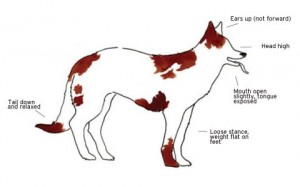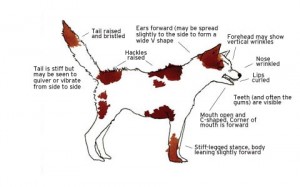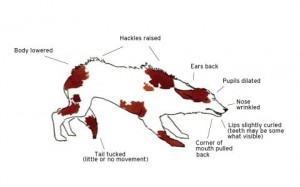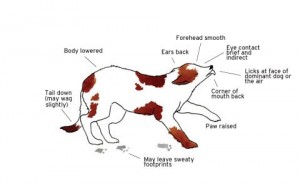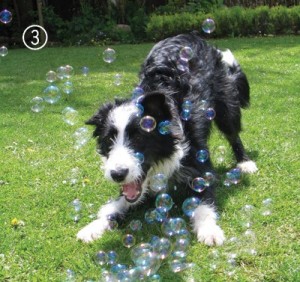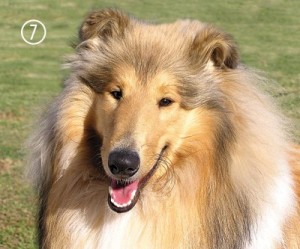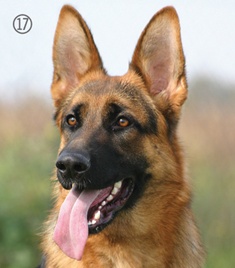HOW FLUENT ARE YOU IN DOG-SPEAK
Dogs are an important part of the lives of many families. It is easy to forget, that even though they are often lovable and loyal, they are still animals. They are not little people in furry suits. Animal behaviour is unpredictable and even the nicest dog can have a bad day. A happy dog is less likely to bite than a dog that is angry, worried, hurt or scared. Children and families can learn to read the dog’s body language and gauge how the dog is feeling. Dogs can communicate in many different ways. Parents who can understand when a dog is signaling that it has had enough attention from a child can intervene before the dog gets to the point of biting or snapping. Even although a dog has never bitten, it may at some point feel that it has no choice but to act aggressively in order to make a child leave it alone. Supervision and observation of dog body language are important in preventing these incidents.
Children who do not have a dog at home will encounter other people’s dogs. It is inevitable that at some point a child will encounter a friend’s, neighbour’s or a strange dog. All children will benefit from knowing how to behave around dogs.
If your dog has ever shown signs or you have that feeling in the back of your mind that your dog is likely to bite someone, then you should get help from a professional. You may think it is expensive to pay a consultant, but it will be even more expensive (in more than just financial ways) if the dog bites someone.
It helps to first learn about the various components that make up dog body language. Dogs use facial expressions, ear set, tail carriage and overall demeanor to signal their intentions and feelings to others. Breaking their body language down into components is helpful at first for building your observation and interpretation skills. Your goal, however, is to be able to observe the entire dog and the situation or context he’s in, in order to accurately determine what he’s trying to say. It’s not possible to understand your dog’s feelings and intentions by looking at just one aspect of his body language.
What is your dog trying to tell you? Dogs have a language that allows them to communicate their emotional state and their intentions to others around them. Although dogs do use sounds and signals, much of the information that they send is through their body language, specifically their facial expressions and body postures. Understanding what your is saying can give you a lot of information, such as when your dog is spooked and nervous about what is going on, or when your dog is edgy and might be ready to snap at someone. You do have to look at the dog’s face and his whole body. The drawings below will help you how to interpret the eight most important messages your dog is sending to you.
This dog is relaxed and reasonably content. Such a dog is unconcerned and unthreatened by any activities going on in his immediate environment and is usually approachable.
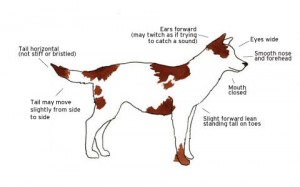
Alert – Checking Things Out
If the dog has detected something of interest, or something unknown, these signals communicate that he is now alert and paying attention while he is assessing the situation to determine if there is any threat or if any action should be taken
This is a very dominant and confident dog. Here is he not only expressing his social dominance, but he is also threatening that he will act aggressively if he is challenged
This dog is frightened but is not submissive and may attack if pressed. A dog will generally give these signals when he is directly facing the individual who is threatening him
Stressed and Distressed
This dog is either under social or environmental stress. These signals, however, are a general “broadcast” of his state of mind and are not being specifically addressed to any individual
This dog is somewhat fearful and is offering signs of submission. These signals are designed to pacify the individual who is of higher social status or whom the dog sees as potentially threatening, in order to avoid any further challenges and prevent conflict
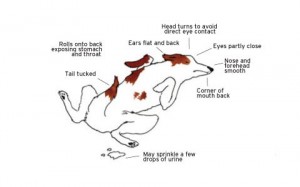
Extreme Fear and Total Submission
This dog is indicating total surrender and submission. He is trying to say that he accepts his lower status by groveling before a higher ranking or threatening individual in the hopes of avoiding a physical confrontation
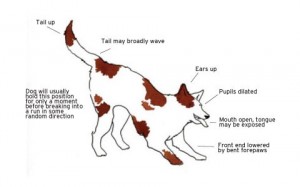
Playfulness
Here we have the basic invitation to play. It may be accompanied by excited barking or playful attacks and retreats. This set of signals may be used as a sort of “punctuation mark” to indicate that any previous rough behaviour was not meant as a threat or challenge.
(1)Standing still for a split second so you have to watch carefully to see what is happening. When a dog is standing still, he bears his weight on one of the three ways: Feet four-squared and balanced (Doberman). This dog is calm and confident. The Collie is demonstrating a curved approach.
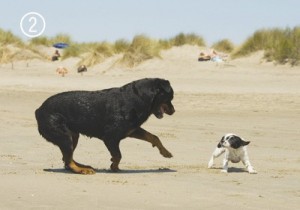
(2)Balanced on his hindquarters. This dog is ready to spring forward, and is confident and willing to interact (Rottweiler). Balanced in such a way that he can bolt away from you or what he is looking at. This little dog is fearful and likely to flee.
Dogs may stand in a variety of off-balanced ways that show you which way they would like to dart away. Darting away indicates fear, so if your dog is standing off balance, try and determine what is frightening him.
(3) This is a dog that is balanced on his forefeet in a meta signal called a play bow, and although he is confident, he is highly aroused and ready to play, not calm. When you look at a dog, it is important to consider his emotional state. Human body language tells us if someone is afraid, confident, or relaxed, and we react appropriately. In the same way, we can help our canine friends by reading their bodies carefully. It is unfair to ask a fearful dog to approach things that frighten him, and likewise it is foolish to approach a dog who is broadcasting aggression unless you know more about his intent.
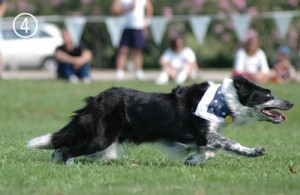
(4)Dogs traveling in straight lines are more likely to be aggressive, while curved lines of travel indicate a friendly encounter. (see Collie in Photo 1). If a dog approaches you in a direct line, looking aggressive, turn away, keeping one eye on him. You will often see this sort of rude behaviour from adolescent dogs who are trying out assertive behaviour, albeit in the wrong context. Standing still, looking down at the ground, and yawning may diffuse the situation. A dog running towards you in this manner is being playful, but it may not be safe – this playful behaviour can be very rough and you can easily be knocked over. The opposite of rocking horse running is flat, efficient movement (photo 4). When a dog moves in this way, he is in a hurry and going as quickly as he can. We often see dogs doing this sort of movement during an aggressive incident.
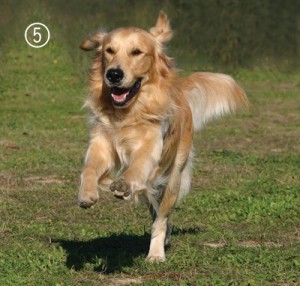 (5) The Rocking Horse Run When dogs are playing, they run in a very particular way. They move vertically almost as much as they move horizontally, rocking back and forth like a child’s rocking horse. Running in this way is inefficient, and reflects that play is all about fun and games, nothing about running your friends down and tackling them.
(5) The Rocking Horse Run When dogs are playing, they run in a very particular way. They move vertically almost as much as they move horizontally, rocking back and forth like a child’s rocking horse. Running in this way is inefficient, and reflects that play is all about fun and games, nothing about running your friends down and tackling them.
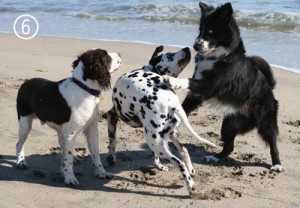 (6)This photo shows a Dalmatian in danger. You can clearly see that the dog is balanced in such a way that he can flee. The Border Collie is on his back legs is bearing his weight on his hind quarters and is willing to bolt forward and hurt the Dalmatian. The third dog, a Spaniel, is standing squarely on all four feet, still and confident, preventing the Dalmatian from escaping.
(6)This photo shows a Dalmatian in danger. You can clearly see that the dog is balanced in such a way that he can flee. The Border Collie is on his back legs is bearing his weight on his hind quarters and is willing to bolt forward and hurt the Dalmatian. The third dog, a Spaniel, is standing squarely on all four feet, still and confident, preventing the Dalmatian from escaping.
The Eyes Have It!
You can read a lot about a dog’s state of mind in the shape and look of his eyes. (7) Almond shaped, relaxed eyes are a reflection of a calm demeanour. (8 + 9) If you can see the sclera or whites of a dog’s eyes, beware; the dog is tense and upset and may bite you. Behaviour specialist call this “whale-eye” (11) Rounded eyes can indicate arousal and surprise
 (10) The Rottweiler mix has a very threatening and dangerous expression. Hard eyes and loose lips are the sort of ambiguity seen in dogs who have been punished for growling in warning. This dog is resource guarding the toy he has.
(10) The Rottweiler mix has a very threatening and dangerous expression. Hard eyes and loose lips are the sort of ambiguity seen in dogs who have been punished for growling in warning. This dog is resource guarding the toy he has.
(12)
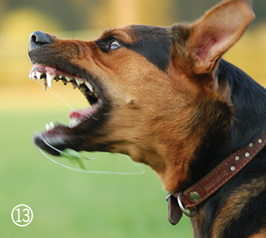 When a dog’s tongue and lips are loose and floppy, don’t worry about that growl – everything is meant in play
When a dog’s tongue and lips are loose and floppy, don’t worry about that growl – everything is meant in play
(13)When a dog is actually going to bite, he pulls his lips and tongue back and out of the way so that his teeth can do their work.
A Tail To Tell
As with tongues, tail talk is different than human body language communication. Dogs use their tails the way that people use smiles. The idea that a wagging tail indicates happiness is similar to thinking that every smile means only one thing. A low, fast-wagging tail is like a nervous laugh.
(14) A high tail slowly wagging is like a confident smile. (15) The middle level, fast wide wag where the tails hits or almost hits the body is comparable to the excited grin.
When looking at tails, look at the base of the tail where it attaches to the body. A dog with a very short tail has as much to say as a dog with a very long tail, and the base of the tail is more telling than the tip. A tail drawn as low as possible in a long-tailed dog will cover the genitals. A tail tightly tucked in indicates extreme fear. The short-tailed dogs are trying very hard, and you can only see that if you look at the base of the tail. A high tail may curve upwards and over the back and this can be confusing in a dog who has a tail that naturally curls over his back, so again, it is important to look at the base instead of the tip to learn the dog’s mood and intent.
Do You Hear What I Hear
Dogs can move their ears independently and almost 180 degrees from the front to the back. In general, consider that the more forward your dog’s ears are, the more confident he is about a given situation. The further back and pinned against his head and neck your dog’s ears are, the more fearful he is. (16)
However, ears serve a dual purpose and can be a bit difficult to read; just when your dog is using his ears to communicate something, he hears something that causes him to pop them out of an easily readable position. Upright, forward ears are attending to what is directly in front of him (17). Then the phone rings and one of his confident , forward ears flicks back to listen.
Ears pulled back tight against the neck tell us that the dog is nervous and concerned (16 and 18) but then the neighbour’s dog barks and the dog flicks one ear forward to listen to that!
Pay attention in general to the general drift of the dog’s ear and as well with the tail.
Many dog bites could be prevented if parents, children and owners were aware of the subtle communication signs that dogs send. Dogs warn before they bite often by yawning or licking their lips. The payoff to learning to read what your dog is saying is better responsiveness to the dog’s need. When you respond to your dog’s needs, you set up a situation where your dog can gain confidence and your relationship with your dog will improve.
You can test your just learned knowledge about dog language by doing the following quiz by clicking on the picture

